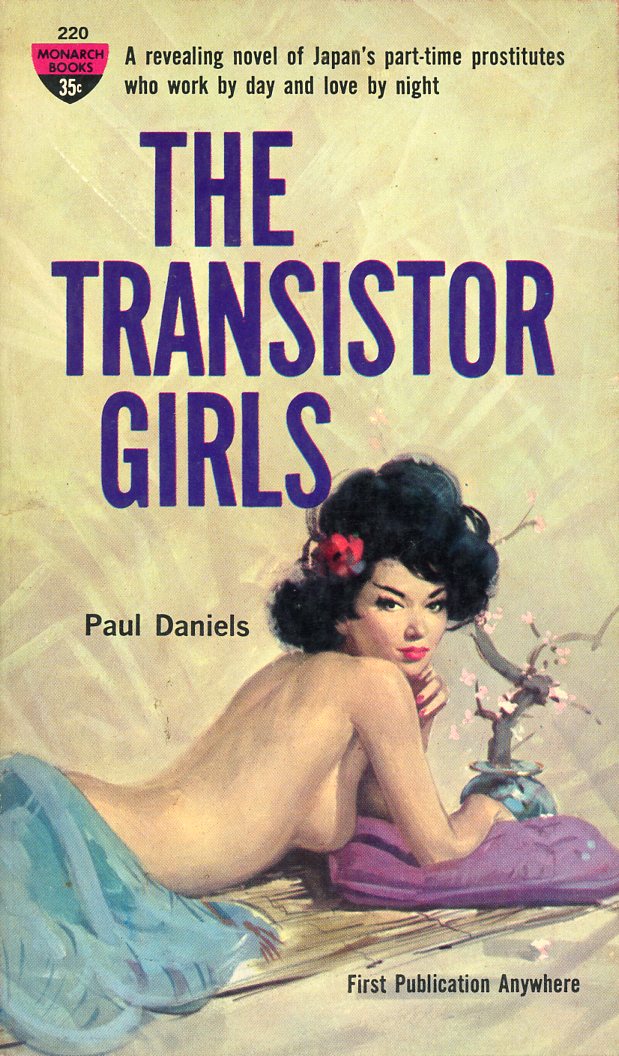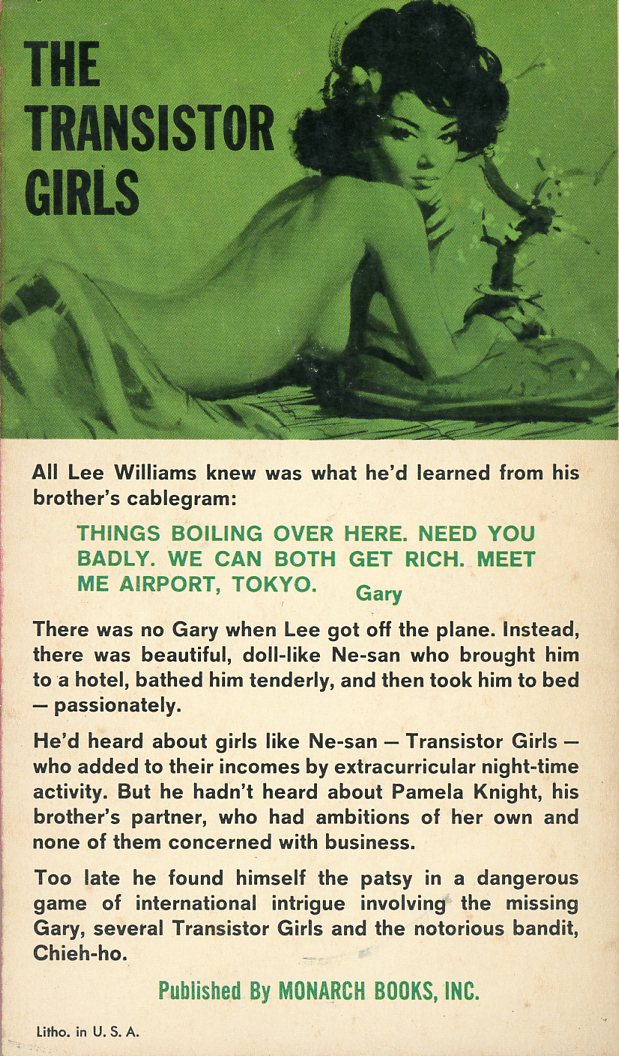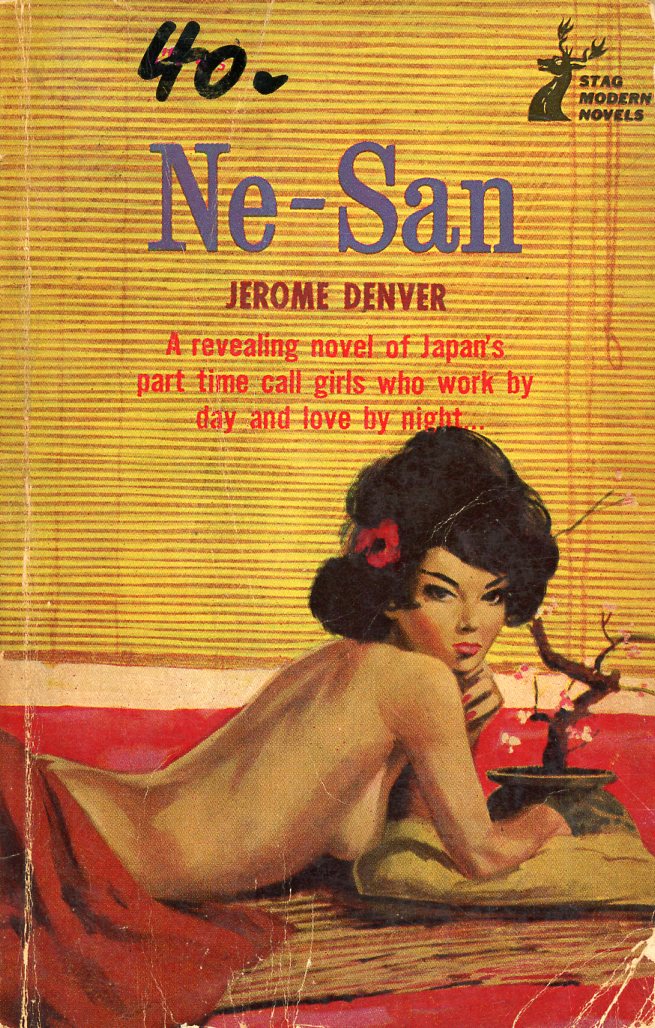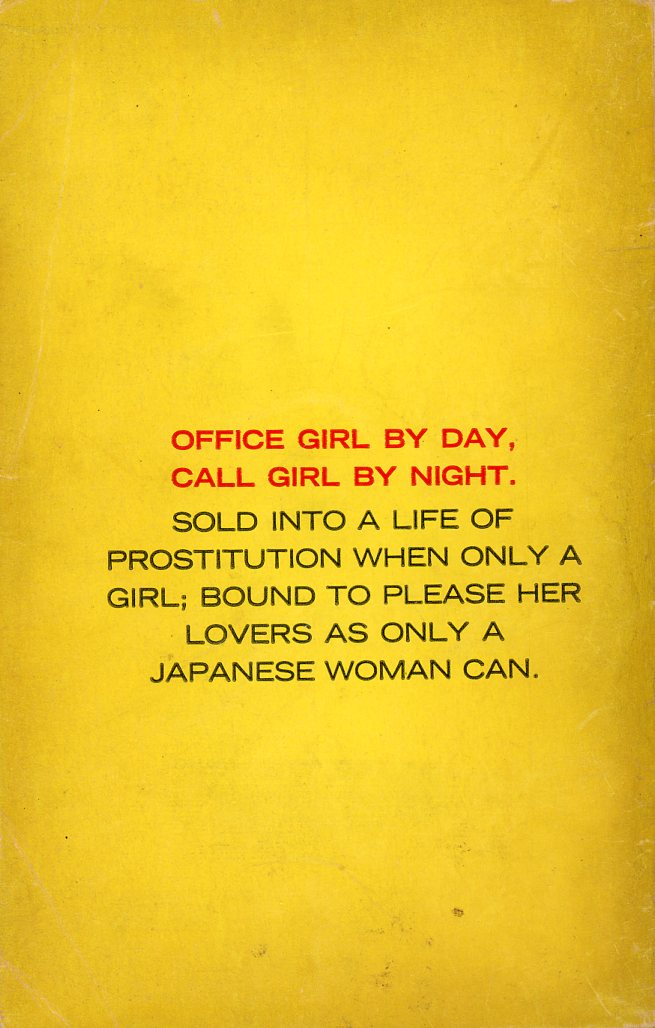Ne-San Transistor Girls
The Aussie respin of a Yankee yarn
By William Wetherall
First posted 1 October 2006
Last updated 7 November 2023
Paul Daniels, The Transistor Girls, 1961
Jerome Denver,Ne-San, 1964
The Transistor GirlsThere are at least two editions of this novel. 1961 Monarch Books edition (220)Paul Daniels The title page of The Transistor Girls bills it as "A Contemporary Novel" that is part of the publisher's "Women Of The World Fiction Series". Paul Daniels is described as "Author of DEBBIE". The copyright page states that the publication is "A Monarch Books Original Novel" and attributes the cover art to a "Cover Painting by Bob Maquire". 1964 Stag Modern Novels edition (SP9)Paul Daniels The above particulars are published in The Taylor Collection of Australian Pulps and Paperbacks: List of Holdings at the University of Melbourne (June 2004, page 48). An image of the cover is shown in "Pulp fictions" on James Hennessy's The Terminal website. Ne-SanThere is, to my knowledge, only one edition of Ne-San. 1964 Stag Modern Novels edition (SP5)Jerome Denver The Yosha Bunko copy of this publication shows "Stag Modern Novels" but not "SP5". The SP5 designation appears on the above Taylor Collection listing at the University of Melbourne. The copyright page on the Yosha Bunko copy states "First Edition 1964" and gives the following particulars. Published by Stag Publishing Co., Printed by New Century Press Pty. Ltd., Distributed by Stag Publishing Co. Order of publicationThe above three publications, on the surface of their particulars, appear to have been published in the following order.
The Transistor Girls versus Ne-SanNarrelle Morris, an Australian scholar, makes the following observation about Jerome Denver's Ne-San in "Innocence to Deviance: The Fetishisation of Japanese Women in Western Fiction, 1890s-1990" (Intersections, Issue 7, March 2002; see review in "Bibliography"). An example of this genre, intended for a Western male audience, is Jerome Denver's Ne-San: A revealing novel of Japan's part time call girls who work by day and love by night [sic] (1964). Ne-San involves two Australian men, John Francis and Danny Degan, who are sent by their Hong Kong company to visit Tokyo as a reward for good work. The managing director was 'aware of the temptations, and he strongly advised [them] to succumb to as many as possible.'[33] While investigating 'the charms of the slant-eyed, kimino-clad [sic] beauties who practised an ancient profession with charm and dignity,'[34] the men fall into an abduction racket involving the pro-Communist brainwashing of other American men. Preposterous plot aside, the novel is very interesting for its depiction of Japan and Japanese women. Many elements of Ne-San -- not only its cover art and blurbs, but parts of its plot and many of its caricatures of Japan and Japanese women -- amount to an Australianized knockoff of The Transistor Girls. Denver, to his credit, created an original story and told it in a stylistically different way. But he clearly began with Daniels' narrative and borrowed many of its elements while featuring Aussies, rather than Yankees, doing preposterous things in Japan. The Transistor Girls is narrated in third person, mostly over the shoulders of Lee Williams, an American who goes to Japan in response to an invitation from Gary Williams, his brother, who fails to meet him at the airport. In contrast, Ne-San is told in first person by John Francis, an Australian, who comes to Japan with Danny Degan, a compatriot, when the two men "who could have been brothers" (page 8) are rewarded by their employer with a week in Tokyo for services rendered in Hong Kong. Denver's Ne-San transistor girls, down to their "slant eyes" and part-time occupations, are clearly based on Daniels' novel. And in both novels, the sexual capers are complicated by Chinese antics. Cover blurbsThe cover blurbs are typical of the genre in the 1960s. Front coversThe blurb on the front cover of Ne-San (1964) in the Stag Modern Novels series is essentially the same as the blurb on the front cover of the Monarch Books edition of The Transistor Girls (1961). However, the blurb on the cover of the Stag Modern Novels edition of The Transistor Girls (1964) is totally different. The Transistor Girls (1961 Monarch Books edition)A revealing novel of Japan's part-time prostitutes who work by day and love by night Ne-San (1964 Stag Modern Novels edition SP5)A revealing novel of Japan's part time call girls who work by day and love by night . . . The Transistor Girls (1964 Stag Modern Novels edition SP9)Their clothing was of the west, but their love rites were founded in the ancient pleasures of the east. Other blurbsOther Ne-San blurbs also derive from Monarch Books edition of The Transistor Girls blurbs but are less creative. "Ne-san" is a protagonist of The Transistor Girls, which opens like this. "I am Ne-san Okamura,"' the girl said. "Are you Mr. Lee Williams?" The back cover blurb of The Transistor Girls equates "Ne-san" with "Transistor Girls" (see scan to right). And the back cover blurb of Ne-San (see scan) is repeated on the free front fly as a definition of "Transistor Girl" like this.
Slant-eyed kangaroosThe Aussie progationists of Ne-San, whose "knowledge of Japan was a vague mixture of hari-kari and geisha girls" (page 8), came to Tokyo to "investigate the charms of the slant-eyed, kimono-clad beauties who practised an ancient profession with charm and dignity" (page 9). As soon as they arrive at their hotel, they head for the Ginza, where they spot the Kangaroo bar, decide it must be run by an Australian, and go in. Inside the bar, they were pretty much ignored. The bartender said a single word to them, in Japanese, which they didn't understand. When asked if he could speak English, he shook his head, but gestured toward the drinks, as though to invite them to choose something. John Francis wonders if they should take the risk. Danny Degan, aware that the bartender is close enough to hear anything he says, tests the waters (page 11). "Not for me. This is probably some sort of clip joint," Danny said knowingly. Then he turned to the barman and grinned broadly. "We wouldn't drink your stinking hooch, you yellow-bellied so-and-so," he told the man in a most amiable fashion. The bartender returned the smile, beaming as though he'd been paid a handsome compliment. He leaned forward, still smiling handsomely with eyes and buck teeth. "Beat it, mugs,["] he said politely. "We're open for regulars. Not for sucker tourists." The two men slink out of the bar, and Francis, as narrator, remarks: "I resolved that next time I saw a kangaroo I'd examine it for slanted eyes." Ne-San is full of this sort of fish-out-of-water humor. Other reportsA number of other reports list or discuss The Transistor Girls and Ne-San. The Taylor Collection 2004The only Google return for "Paul Daniels" and "Jerome Denver" in October 2006 when I first posted this review was a PDF file available from the library of the University of Melbourne, consisting of a "List of Holdings" of The Taylor Collection of Australian Pulps and Paperbacks, dated June 2004, and running 68 pages. The list includes both Ne-San (SP5) and The Transistor Girls (SP9). The portal to the Taylor Collection describes the collection as follows. The Taylor Collection of pulp and popular fiction is a collection of nearly five thousand paperbacks and pulp digests published in Australia between the 1940s and the 1980s. The collection ranges across all genres of popular fiction and sensationalised non-fiction, including crime, war, science fiction, westerns, romance, and erotica. Pulp International 2014The two novels are also respresented on the "Asia Pacific" page of Pulp International dated 16 August 2014. James Hennessy 2022By the time of this edit in November 2023, others had pursued the story of the The Transistor Girls and Ne-San, including James Hennessy on 1 November 2022 on "Pulp Fictions" page of The Terminal website. Hennessy posted an image of a Stag Modern Novels edition, with different cover art and a very different cover blurb (see image above), and he describes Stag Publishing as a "long-defunct Sydney erotic paperback house". |
||||||||||
The many faces of Paul W. Fairman
Paul Daniels was one of several pseudonyms used by Paul Warren Fairman (1909-1977), a science fiction writer and editor.
During the 1950s, Fairman edited several magazines, including Amazing Stories and Fantastic. He then devoted himself to writing, and in two decades he wrote and ghosted numerous stories and novels in various genres.
Fairman published most of his science fiction and fantasy under his own name, though he also wrote some imaginary fiction as Ivar Jorgenson and Adam Chase. He also ghosted three of Lester del Rey's novels, which del Rey (1915-1993, Leonard Knapp, aka Ramon Felipe Alvarez-del Rey, aka Erik van Lhin) was unable to complete.
Fairman seems to have used Paul Daniels only in the early 1960s, when writing the Bedside and Monarch stories, which booksellers variously call esoteric, erotic, or adult. From 1968 to 1971, as F.W. Paul, he wrote ten novels in the "Man From S.T.U.D." series, published by Lancer Books in New York, in rivalry with "The Man From O.R.G.Y." series by Ted Mark (Theodore Mark Gottfried, b1928).
Also in the late 1960s and early 1970s, Fairman wrote some Gothic romance and Gothic horror titles as Janet Lovesmith for Popular Library, and as Paulette Warren for Lancer, Magnum, Manor, Popular Library, and Berkley.
Paula Fairman
"Paula Fairman" might also seem like a female alter ego of Paul Fairman. But it is one of several pen names used by the even more prolific writer Robert Vaughan (b1937). One of Vaughan's better known racy historical romance titles as Paula Fairman, also reviewed on Steamy East, is Jasmine Passion (1981), which is set in China and the Barbary Coast of California.
Paul Daniels in America and Australia
Paul Daniels published the following novels, all erotic action stories, through Bedside/Bedtime Books (New York, Valiant Publications) and Monarch Books (Derby, Connecticut; New York, Monarch Publishing).
Bedside / Bedtime Books
1960 Motel Girl (Bedside 970)
1960 Appointment With Passion (Bedside 977)
Monarch Books
1961 Debbie (Monarch 202)
1965 Debbie (Monarch 554, Reprint of 202)
(Life & Loves of a New York Model)
Cover by Rafael DeSoto
1962 Playboy (Monarch 233)
(Wall Street, Passion & Violence)
Cover by Ray Johnson
1962 The Cover Girls (Monarch 254)
(Young Girls on Magazines)
Cover by Harry Schaare
"At work or play, she always got what she wanted"
1962 The Show Girls (Monarch 291, 139 pages)
"Woman of the World Fiction Series"
1962 Ruby (Monarch 299, 139 pages)
(Sex, Scandals & Suspense in Manhattan)
"She had love in her eyes and sin in her heart"
1963 Pattern For Destruction (Monarch 394, 125 pages)
(New York Sex & Suspense)
"You could damn Libby or even hate her -- but you couldn't resist her"
1964 Jealous (Monarch 422, 124 pages)
Monarch Publishing
Cover art by Ernest Chiriaka [Cover by Darcy?]
"A compelling novel of a woman trapped by one man's obsessive mistrust"
Paul Daniels and Jerome Denver have something in common: both were published by Stag Publishing in 1964.
In addition to the Stag Modern Novels edition of The Transistor Girls (SP9), Stag Publishing also put out the following Stag titles by Paul Daniels in 1964.
Stag Publishing
1964 Libby (London)
"Pattern of Destruction. You could damn her, or even hate her, but you couldn't resist her"
1964 The Cover Girls (Sydney, 162 pages)
"A nightmare of terror confronts a girl who will do anything to hit the front cover"
Jerome Denver
Stag Publishing seems to have reissued a number of Monarch titles as they were originally published but with new artwork. But the only Stag book attributed to Jerome Denver -- the only title I can find anywhere that bears this by-line -- is Ne-San.
Why did Stag choose to Austalianize The Transistor Girls in the guise of Ne-San? Simply to boost the egos of Australian men?
Did Fairman allow someone to rewrite his story under the name "Jerome Denver"? Given the strong Aussie flavor of Ne-San, it would seem unlikely that Fairman himself was Jerome Denver.
Paul Warren Fairman (1909-1977) was born in St. Louis, Missouri and died in Newark, New Jersey. I have not been able to discover whether he spent any time of his life in Australia. He seems to have been living in Newark, New Jersey at the time The Transistor Girls and later Ne-San were written.
"Jerome Denver" is not a particularly common name. There is a Jerome Hotel in Denver. The Denver-based agency Platinum Talent is owned by a Stephanie Jerome.
Ed Prentiss (Paul Edward Prentiss, 1908-1992) played a character called Jerome Denver in the "Iron Star" episode of The D.A.'s Man TV drama series. The episode was aired on 4 April 1959 (Season 1, Episode 13).
Otherwise "Jerome Denver" draws a dead blank.
But could he have been another of Paul Fairman's alter egos?
In other words, was Paul Fairman ripping off his own story?




